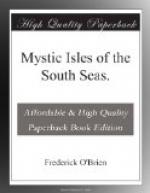Wrestling was the most notable amusement, and boxing was fashionable for women, some of whom were skilled in fistic combats. The wrestlers, as their Greek prototypes, first invoked the favor of the gods, and offered sacrifices when victorious. The palestra was on a lawn by the sea, and in formal contests district champions met those of other districts, and islands competed for supremacy with other islands. The maona wore a breech-clout and a coat of cocoanut oil freshly laid on, but not sand, as in the Olympiads. When one was thrown, the victor’s friends shouted in triumph and sang and danced about him to the music of tom-toms, while the backers of the loser met the demonstrations with ridicule. This was much like the organized yelling on our gridirons; and when the wrestling began again there was instant silence. It was all good-humored, as was the boxing.
Spear-throwing and stone-slinging at targets were both fun and preparation for war, for in the battles the slingers took the van. The stones were here, as in the Marquesas, as big as hens’ eggs, and rounded by the action of the streams in which they were found. Braided cocoanut-fiber formed the sling, or flax was used, and looped about the wrist the sling was flung down the back, whirled about the head, and the missile shot with deadly force and accuracy.
Archery was associated with religion in Tahiti, as in Japan, between which countries there are many strange similarities of custom. The costumes of the bowmen and their weapons were housed in the temple, and kept by devotees, and were removed and returned with ceremonies. The bows, less than six feet, the arrows, half that long, were never used in war or for striking a mark, but merely for distance shooting, and the experts were credited with reaching a thousand feet.
Tatini had pointed out to me, when we walked the peninsula of Taravao, a projecting rock, marked with deep-worn grooves, from which the Tahitians once flew very large kites. These were tied to the rocks, and the ropes of cocoanut sennit in the course of hundreds of years had worn the stones away. Often when the wind was favorable, they intrusted themselves to their kites, and slipping the ropes, flew to the opposite side of the bay, forerunners in the air of a certain Lyonnais of 1783, and contemporaneous with the Siamese who centuries ago indulged their levitative dreams by leaping with parachutes.




